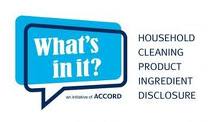The maturing of our supply chain...Supply chain management and brand protection domestically and world-wide is a priority for most companies. Climbing aboard the green bandwagon of environmentalism is nothing new, but being the leader in supply chain transparency is.
 The passage of REACH in 2007 was an impetus to supply chain transparency, requiring companies manufacturing and selling into the European Union to bear legal obligations for certain aspects of supply chain transparency. While REACH is required for business in the EU, establishing and maintaining this supply chain transparency domestically is the new “socially responsible” supply chain paradigm. Such chain transparency is supported by the Dodd-Frank Wall Street Reform and Consumer Protection Act of July, 2010 (the “Conflict Minerals Law”) and California’s Supply Chain Transparency Act (SB 657) passed in September 2010. With SB 657 we are not just addressing transparency of substances in products, we are addressing public disclosure efforts to eradicate slavery and human trafficking from supply chains. SB 657 will affect over 3,000 companies including major brands, retailers, vendors, and suppliers with headquarters outside of California and the United States. On a larger scale, Representative Carolyn Maloney (D-New York) has announced that she will introduce a federal bill modeled after SB 657.
The passage of REACH in 2007 was an impetus to supply chain transparency, requiring companies manufacturing and selling into the European Union to bear legal obligations for certain aspects of supply chain transparency. While REACH is required for business in the EU, establishing and maintaining this supply chain transparency domestically is the new “socially responsible” supply chain paradigm. Such chain transparency is supported by the Dodd-Frank Wall Street Reform and Consumer Protection Act of July, 2010 (the “Conflict Minerals Law”) and California’s Supply Chain Transparency Act (SB 657) passed in September 2010. With SB 657 we are not just addressing transparency of substances in products, we are addressing public disclosure efforts to eradicate slavery and human trafficking from supply chains. SB 657 will affect over 3,000 companies including major brands, retailers, vendors, and suppliers with headquarters outside of California and the United States. On a larger scale, Representative Carolyn Maloney (D-New York) has announced that she will introduce a federal bill modeled after SB 657.
 Some companies are responding to this type of legislation, anticipating emerging similar legislation, and are already setting a new standard for supply chain transparency. Efforts made by these leaders in supply chain transparency will continue to set the bar higher with voluntary disclosure, and will and push us to new levels of disclosure until full disclosure in every product is made available - either by law or by a pursuit of competitive advantage. Examples of this legislation include New York’s Household Cleansing Product Disclosure that requires manufacturers of household cleaners to disclose to consumers what chemicals are in their products. Specific language may require companies to disclose any chemicals in their products that cause nerve damage or hormone disruption, even if industry asks to keep this information secret from consumers. Similar disclosures efforts, such as the Accord Initiative in Australia, are already in place. The Accord Initiative is a voluntary approach to providing consumers with information on the ingredients in household products. Already seven major chemical companies, covering almost 80% of their industry market share, have signed up to "What's in it?", committing to disclose all ingredients in certain products by July 2011. Advocates for these laws insist that consumers have the right to know, which mirrors REACH’s Article 33 requirement that suppliers of products that contain certain substances must furnish information regarding those products within 45 days of a consumer request.
Some companies are responding to this type of legislation, anticipating emerging similar legislation, and are already setting a new standard for supply chain transparency. Efforts made by these leaders in supply chain transparency will continue to set the bar higher with voluntary disclosure, and will and push us to new levels of disclosure until full disclosure in every product is made available - either by law or by a pursuit of competitive advantage. Examples of this legislation include New York’s Household Cleansing Product Disclosure that requires manufacturers of household cleaners to disclose to consumers what chemicals are in their products. Specific language may require companies to disclose any chemicals in their products that cause nerve damage or hormone disruption, even if industry asks to keep this information secret from consumers. Similar disclosures efforts, such as the Accord Initiative in Australia, are already in place. The Accord Initiative is a voluntary approach to providing consumers with information on the ingredients in household products. Already seven major chemical companies, covering almost 80% of their industry market share, have signed up to "What's in it?", committing to disclose all ingredients in certain products by July 2011. Advocates for these laws insist that consumers have the right to know, which mirrors REACH’s Article 33 requirement that suppliers of products that contain certain substances must furnish information regarding those products within 45 days of a consumer request.
 Leaders in domestic supply chain transparency have already emerged and include household cleaner manufacturing giant SC Johnson, who intends to disclose chemical ingredients in its products through product labels and a website. Seventh Generation has been publicly disclosing ingredients in their products since 1990, and Clorox recentlyannounced that it will disclose the specific preservatives, dyes and fragrances it uses in its cleaning, disinfecting and laundry products sold in the U.S. and Canada. Also recently, Clorox has developed a mobile application to make it even easier for consumers to see the chemical composition of its products and what those chemicals do.
Leaders in domestic supply chain transparency have already emerged and include household cleaner manufacturing giant SC Johnson, who intends to disclose chemical ingredients in its products through product labels and a website. Seventh Generation has been publicly disclosing ingredients in their products since 1990, and Clorox recentlyannounced that it will disclose the specific preservatives, dyes and fragrances it uses in its cleaning, disinfecting and laundry products sold in the U.S. and Canada. Also recently, Clorox has developed a mobile application to make it even easier for consumers to see the chemical composition of its products and what those chemicals do.
These new disclosures mark the first time that mainstream cleaning product manufacturers have disclosed all the ingredients used in some or all of their products. Supporters of the cleansing product disclosure maintain that, because household cleansers are products so widely used, requiring full disclosure of their ingredients would be a good start toward requiring full disclosure of all ingredients in all products. Mirroring the food and nutritional labeling disclosures established by the FDA that apply to ingredients in food, full disclosure on all product ingredients is clearly in our future and the leaders of ingredient full disclosure and supply chain transparency are already setting the standard for ease of use via their website and, in return, will reap the rewards for leading the pack. Domestic full ingredient disclosure laws have had starts and stops in the past. Hopefully these false starts will be a thing of the past given increased environmental and governmental demands, coupled with consumer and corporate response to such disclosure laws. In the mean time, information on what may be in other consumer products can be found in The Good Guide, a resource that provides health, environment, and social performance of products and companies.


